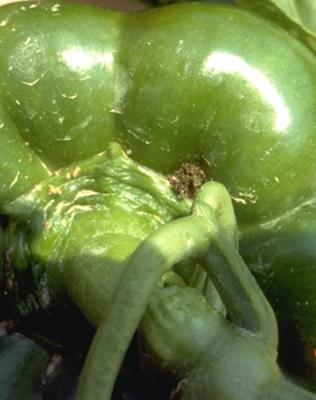Over 200 species of plants including peppers, and sweet corn
European corn borer larvae are whitish with dark brown spots. Mature larvae are 3/4 to 1 inch long. Adult moths are patterned brown and tan and about 1/2 inch long. Eggs are laid in clusters on leaves. The larvae hatch and tunnel into the stem or fruit of the host plant.
In sweet corn, larvae tunnel through the stem of the plant causing reduced yield and possibly stalk breakage. In peppers and beans, the larvae tunnel into the stems, which weakens them and reduces yield. They also tunnel into the fruit of peppers and the pods of beans. European corn borer also feeds on potato leaves and bores into the stem, particularly in the first generation. This causes a yield reduction in some potato varieties.
Larvae overwinter in the stems of plants. There are two to three generations per year.
Sweet corn is typically planted several times during the growing season. The way in which the European corn borer attacks the plant depends on the growth stage of the plant rather than the time of year. In whorl-stage corn, scout for shot-hole feeding on leaves and for larvae in whorls. Treat during late whorl if more than 15 percent of plants show larval feeding. Treat before larvae bore from the whorl into the stalk. From tassel emergence through harvest, observe light traps for corn borer moths. Treat if counts exceed fifty moths per trap per night. Treat every five to seven days until ten to twelve days before harvest. Peppers should be treated at about five-day intervals when peppers are fruiting, if light traps are capturing more than five to ten European corn borer moths per night. The likelihood of damage is reduced if nearby corn is suitable for corn borer egg laying. Beans should be treated if light traps capture more than twenty-five moths per night and bean pods are at least 1 inch long. Treatment intervals vary from two to seven days, depending on the insecticide used. Larvae that hatch in the last two or three days before harvest will not mature enough to enter pods. Potatoes may have a problem if light traps capture more than twenty-five moths per night. Another indication of a potential problem is an average of more than one egg mass per twenty-five leaves. Action depends, in part, on the susceptibility of the potato varieties.
